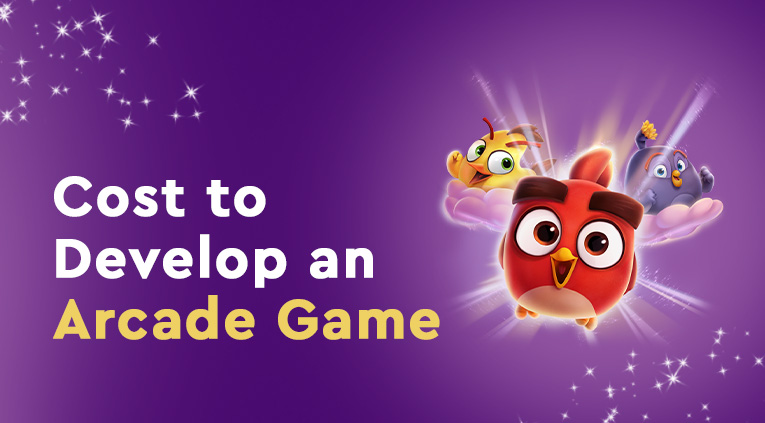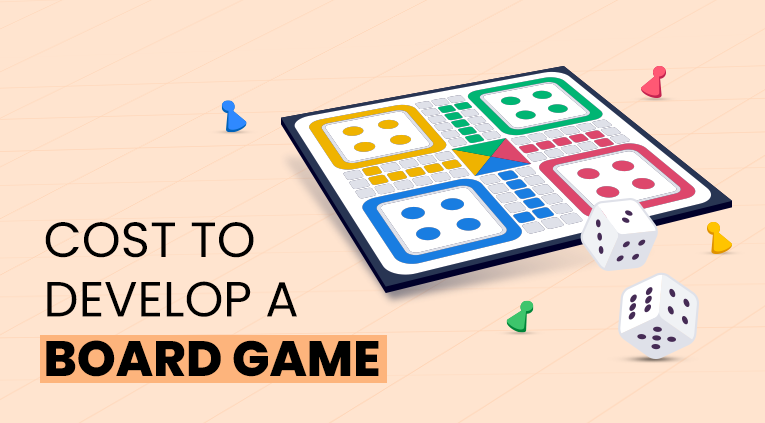The trend of puzzle game development has been on the rise due to its popularity among gamers. While puzzle games are relatively straightforward to develop, several considerations still go into calculating the cost.
You can either develop a minimalistic or a more complex puzzle game. The latter will require more time and resources, thus increasing the cost of development. In addition, you need to decide on the type of game you want, such as a 2D or 3D puzzle game.
This article will explore the various factors influencing the cost of developing a puzzle game. Before we dive into the aspects of puzzle games, let’s look at some statistics.
Puzzle Game Statistics
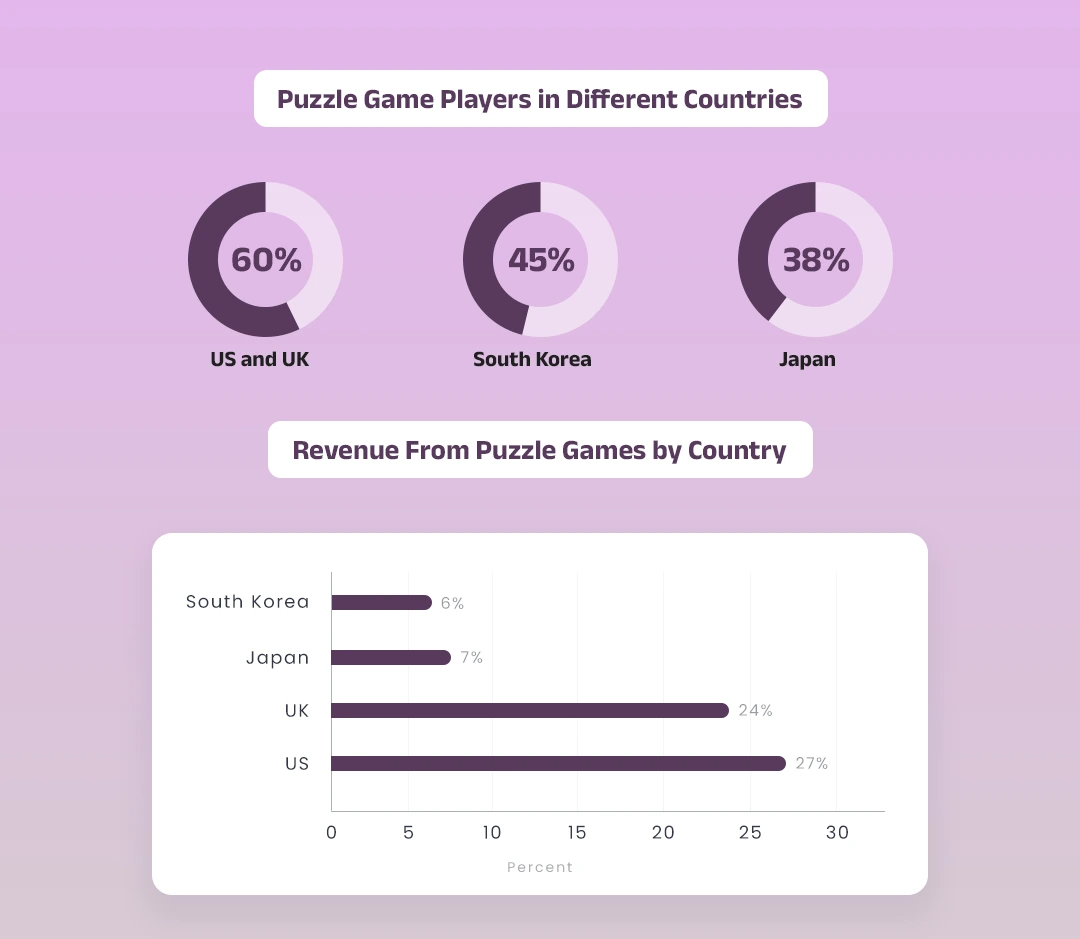
1. According to reports, puzzle games are the most popular in the US and the UK, with around more than 60% of active players. Furthermore, South Korea is in second place with 45% of players, and Japan is in third position with 38% of puzzle players.
2. When it comes to revenue from puzzle games by country, these games attract 27% of revenue from the US, 24% in the UK, 7% in Japan, and 6% from South Korea.
3. Users playing puzzle mobile games are women over the age of 35, as they’re handy, on the go, and fun to play.
After exploring these statistics, let’s check out the benefits of developing a puzzle game with professional puzzle game development services.
Benefits of Creating a Puzzle Game
Puzzle games are a great way to keep your brain active, as well as improve cognitive skills, such as problem-solving and logic. These games are gaining a massive amount of popularity due to the range of cognitive benefits they provide.
Below are some of the significant benefits of puzzle games for both businesses and users.
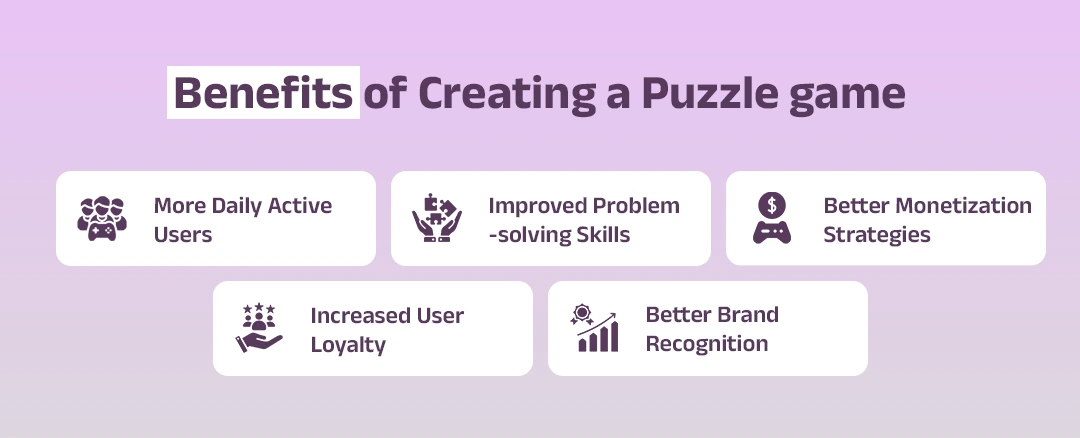
1. More Daily Active Users
Puzzle games have a wide range of users, ranging from kids to adults. This ensures that more people are actively engaging with the game on a daily basis. Furthermore, these games promote a sense of satisfaction and accomplishment, both of which motivate people to keep playing.
When businesses have gaming platforms where the daily user count is consistently high, it helps the company gain more attention and visibility. It becomes easier for businesses to reach out to more potential customers and even gain new ones.
2. Improved Problem-solving Skills
Users get a sense of satisfaction when they solve challenging puzzles. Through puzzle games, players are able to hone their problem-solving skills and develop a better ability to plan out their strategies before taking action.
Furthermore, puzzle games require players to remember certain patterns and sequences in order to complete the levels. This promotes better short-term memory retention as well. In addition, the more users play these games, the better their analytical and deductive skills become.
3. Better Monetization Strategies
As these games are highly intuitive, businesses can use them to develop better monetization strategies and engage more users. Furthermore, puzzles are a great way to offer incentives for users who reach certain levels, thus resulting in more active users and longer engagement with the game.
For example, businesses can offer rewards for users who complete certain levels of the game or offer in-app purchases that enhance gameplay. Other popular monetization strategies include advertising, sponsorships, and transaction fees.
4. Increased User Loyalty
Puzzle game development encourages users to stay with the game longer as they become more engaged in solving puzzles. This helps businesses create a loyal user base who can be relied upon for regular engagement and feedback.
In addition, puzzle games also promote user interaction and collaboration. Players are able to interact with each other while playing the game, which builds a sense of community and loyalty among them. This helps businesses to foster stronger relationships with their user base and create better engagement opportunities.
5. Better Brand Recognition
Unique and innovative puzzle game design can help businesses gain more attention and recognition from potential customers. It also helps in building a strong brand identity as the puzzles become associated with the company.
This allows businesses to stand out from their competitors and be easily recognizable in the market. It becomes streamlined for businesses to create an effective marketing strategy that focuses on their puzzle games, thus helping them generate more revenue.
Overall, puzzle games can be beneficial for companies and users as they offer multiple benefits. On this note, let’s look at how to develop your bespoke puzzle game.
How to Develop a Puzzle Game?
Before you hire puzzle game developers, it’s crucial first to understand the basics of game development and how to create a puzzle game that players will enjoy. Once you have a clear idea of the kind of game you want to create, you can begin to develop your puzzle game.
There is a significant variation when it comes to developing a puzzle game. Most puzzle games have some mechanics or set of rules that must be followed in order to solve the puzzles. To make sure your puzzle game is engaging, you must include a variety of puzzles that challenge the player and are fun to solve.
Below are some common aspects of developing a custom puzzle game for your audience.
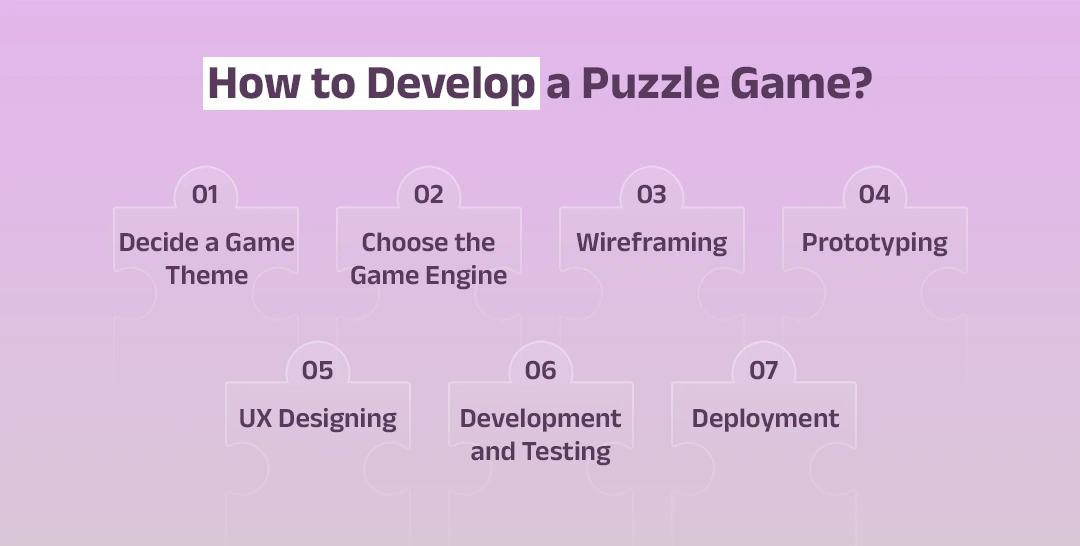
1. Decide a Game Theme
A game’s theme will help to decide the type of puzzles you create. You may choose an existing genre, such as a word puzzle, logic puzzle, or match-3 game, or create an entirely new type of puzzle. Consider what kind of puzzles would make your game unique and how the theme ties into the puzzles.
To gain a competitive edge and offer a better user experience, you need to do some research on the current trends in puzzle games. Analyze what kinds of puzzles are popular, and learn from the successes of other puzzle game developers.
2. Choose the Game Engine
The game engine is the software used to create a puzzle game. Some popular choices are Unity and Unreal Engine, both of which are ideal for creating a puzzle game. It’s important to choose an engine that is suitable for the type of puzzles you want to create.
Unity supports 2D and 3D games, while Unreal Engine is more suited to 3D puzzle games. Choose an engine that can support all the features you need during the mobile game development process.

3. Wireframing
Wireframing is the practice of creating a basic outline of how your game should look and feel. While wireframing your game, ensure that the user’s journey is easy to understand and engaging. This will help you create a game that appeals to your target audience.
Some of the popular tools for puzzle game wireframing include InVision, Adobe XD, and Figma. You can also use paper prototypes to get a better idea of how the gameplay will feel. Go for professional game development services if you want to ensure your game design is up to scratch.
4. Prototyping
Prototyping is the process of creating a basic version of the game before it’s ready to be released. This helps in testing the game design and mechanics without investing in high-cost development services.
When prototyping your puzzle game, use simple tools such as Twine or GameMaker Studio 2 to create a rough sketch of the game. This will give you a sense of how the gameplay works and what needs to be tweaked before the final version is released.
5. UX Designing
UX is the practice of creating an enjoyable user experience for players. It is essential to factor in UX design in developing a puzzle game as it has an integral role in engaging players. UX focuses on usability, accessibility, and other aspects of player interaction in the game. While designing a game, ensure that the navigation and user flow are simple and easy to use.
Ensure that the puzzles are fun and quick to play, as players can get bored quickly if the puzzles are too difficult or take too long to solve. By optimizing UX, you can create a game that is engaging and enjoyable to play.
6. Development and Testing
Once you have the basic game design ready, it is time to move on to actual game development. This includes coding and designing the graphics for your game. To make sure that everything works as intended, you must test the game continuously throughout development.
You can use a variety of tools, such as Appium and Selenium, for testing a puzzle game. This will help you identify any bugs and errors in the game before it is released to the public.
7. Deployment
Once your game is ready, it is time to deploy it to a variety of platforms, such as the App Store, Google Play Store, and web browsers. Also, focus on implementing monetization strategies such as in-app purchases and ads to make your game profitable.
After exploring the process, let’s explore how much time it takes to develop a bespoke puzzle game for your users.
How Long Does It Take to Build a Puzzle Game?
Building a custom puzzle game can be a time-consuming process, depending on the complexity of the puzzles and features involved. On average, it takes around 6 to 8 months to develop a puzzle game from scratch. This includes the time taken for design, development, and testing.
However, if you are using an existing game engine, the development time can be reduced significantly. If you are looking to create a simple puzzle game with basic design elements, it can take around 4 to 6 months. It’s better to consult a professional puzzle game development team to have an accurate idea about the development process.
Factors Affecting the Cost of Creating a Puzzle Game
With the advancements in gaming engines, the puzzle games genre has seen a number of variations and releases over the past few years. When it comes to creating such a bespoke game, there are several factors that can influence the cost.
Below are some of the key considerations that can impact the budget required to create a puzzle game.
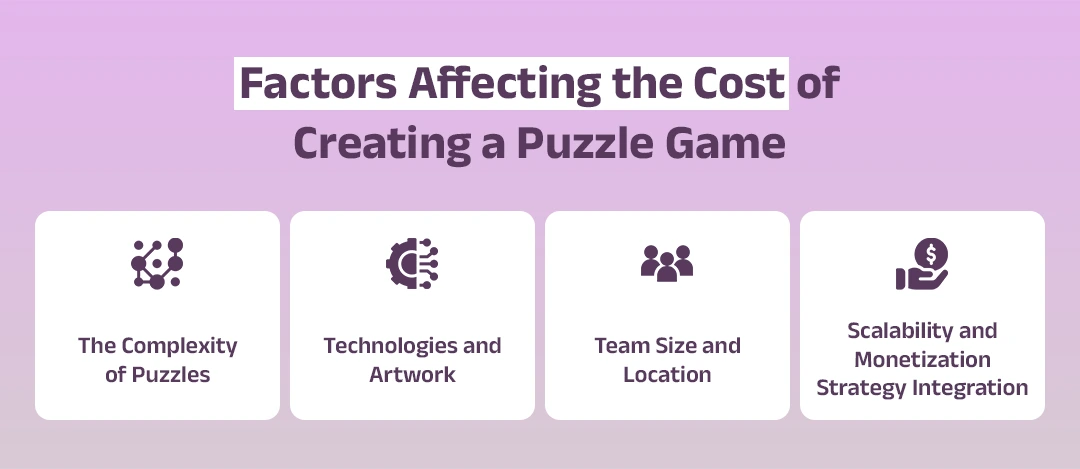
1. The Complexity of Puzzles
The more complex and unique the puzzles are, the more knowledge and effort will be required to develop them. This can affect the cost significantly, as additional resources or third-party services may need to be brought on board to complete development.
Before you hire game developers, consider doing competitor research on what types of puzzles they are using and how complex they are. This will give you a better understanding of the requirements needed to create something similar.
2. Technologies and Artwork
The cost of developing a puzzle game is affected by the technologies chosen for the project. Complex 3D puzzles will require additional development time and may even require different platforms or specialist tools to build them. It is essential to research which technology suits your budget and requirements best before commencing development.
High-quality artwork and graphics will be needed to make the game aesthetically pleasing, which can add an extra layer of complexity. It is important to consider how much you are willing to invest in this area, as it will have a direct impact on the cost of development.
3. Team Size and Location
The size and location of the game development team will also affect how much it costs to create a puzzle game. Larger teams with more experienced game developers can increase your budget significantly, while smaller teams or remote workers can be more cost-effective.
It is important to factor in all of these considerations when deciding on the right game development team for your project. Thus, before you begin your hunt for experienced puzzle game developers for hire, it’s important to figure out your budget and the factors that can affect it.
4. Scalability and Monetization Strategy Integration
Finally, your scalability and monetization strategy can affect the cost of developing a puzzle game. Additional development will be required if you plan to integrate any in-app purchases or subscription models. This can add an extra layer of complexity and therefore increase the overall budget for the project.
Consider all the aforementioned aspects to make sure you get the best value for money when developing a puzzle game. Now, let’s look at how much it costs to develop your custom puzzle game.
How Much Does It Cost To Develop a Puzzle Game?
As discussed above, the cost of creating a puzzle game can vary depending on the complexity, technologies used, and development team chosen. Developing a simple 2D or 3D puzzle game can cost anywhere between $25,000 to $45,000. In order to make a complex puzzle game with advanced features and functionality, you will need to spend at least $45,000 to $65,000 or more.
However, these figures are just estimates, and the actual cost can be much higher depending on the features and technologies used. Taking help from a professional game development company can guide you in detail about the cost involved in creating a puzzle game and provide you with more accurate estimates.

Next, let’s discuss some of the critical strategies to reduce and optimize the cost of developing a puzzle game so that you can have the most out of it.
Bonus Point: Strategies for Reducing Puzzle Game Development Cost
It’s possible to optimize the cost of game development solutions as there are multiple ways to reduce the overall expense of development. These strategies will help game developers to save on their budget without compromising the quality and user experience of their completed product.
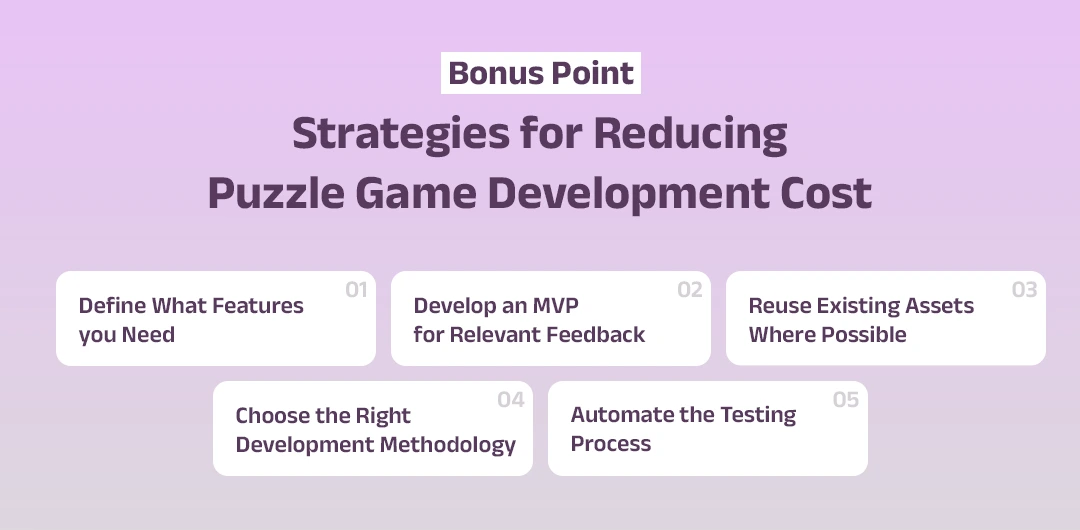
1. First, Define What Features you Need
It’s important to clearly define the core features of your game before you start. This helps you prioritize what is essential for the game, and it prevents scope creep and the associated costs. After you perform the market research, you can decide what features should and shouldn’t be included.
2. Develop an MVP for Relevant Feedback
Developing an MVP (minimum viable product) can help you test the market and gather feedback from users. This helps you identify areas that need improvement so that you don’t waste time and money on features that users won’t like or use. You can also use the MVP to gather more accurate statistics on the success of your game.

3. Reuse Existing Assets Where Possible
There are many free tools, templates, and assets available for game developers to utilize. Reusing existing assets wherever possible will reduce the time and cost associated with creating new ones from scratch. There are also many cost-effective outsourcing options that you can use to get the job done quickly and efficiently.
4. Choose the Right Development Methodology
The development methodology you choose will have a significant impact on the time and cost associated with game development. Choosing an agile approach will allow you to quickly iterate on the game’s design and features, while a waterfall approach may be more suitable for large-scale projects.
5. Automate the Testing Process
Automating the game development and testing process will help you save time and money. Automation can be used to quickly identify and fix bugs, meaning that the game is released faster with fewer errors. Automation also helps you to quickly identify in-game performance issues, allowing you to rectify them and improve the user experience quickly.
By utilizing these strategies, game developers can reduce the cost of puzzle game development without compromising the quality of their product. With careful planning and a focus on efficiency, developers can create cost-effective solutions that meet their needs and exceed user expectations.
Furthermore, it becomes important to go for reliable mobile game development solutions from an experienced game development agency like AGS. A professional game development agency will provide a quality solution that maximizes your budget, ensuring you get the most out of your investment.
Why Hire Auxano Global Services?
Auxano Global Services is a leading game development agency with experienced developers and a proven track record of delivering exceptional games. We have an established process that ensures successful delivery and timely completion of the project at budget-friendly prices.
We use advanced technologies, and our developers have hands-on experience in the development process to deliver the best possible solution. Our developers understand the importance of pixel-perfect design, intuitive user experience, and performance optimization.
We provide complete support throughout the development process, including product strategy, market analysis, design and development, testing, and deployment. We are also well-versed in the latest technologies, such as Unity 3D and Unreal Engine.
At Auxano Global Services, we understand the importance of cost-effective puzzle game development, and our team is dedicated to providing the best possible solution for your project.
Wrapping up!
As the demand for puzzle games continues to grow, it’s the right time for companies to invest in developing quality puzzle games. With careful planning and budget management, you can develop a cost-effective yet high-quality game that stands out from the competition and delivers a great user experience.
At Auxano Global Services, we provide cost-effective puzzle game development solutions that are tailored to meet your needs. In 2024 and beyond, when the gaming industry is booming, make sure your business is ready with the right development solutions to capitalize on the opportunity.
Frequently Asked Questions
-
1. How much does it cost to develop a puzzle game?
The cost of developing a puzzle game depends on factors such as the complexity of the game, the number of features, and the development methodology chosen. On average, it costs around $25,000 to $45,000 to develop an MVP puzzle game. In order to make a complex puzzle game with advanced features and functionality, you will need to spend at least $45,000 to $65,000 or more.
-
2. Why are puzzle games so popular?
Puzzle games are popular because they challenge players and keep them engaged. They offer a unique experience with endless possibilities and can be enjoyed by all age groups. Furthermore, they offer a great way to pass time and relax.
-
3. Which technology is used for developing puzzle games?
The most popular technologies for developing puzzle games are Unity and Unreal Engine. Both of these engines offer powerful tools, allowing you to create high-quality 3D graphics with ease.
-
4. How much time does it take to develop a puzzle game?
The time taken to develop a puzzle game depends on the complexity of the game, the number of features, and the development methodology chosen. On average, it takes around 6 to 8 months for a simple puzzle game.
-
5. What are some popular monetization strategies for puzzle games?
Some popular monetization strategies used in puzzle games are in-app purchases, subscription plans, advertisements, and affiliate programs.



